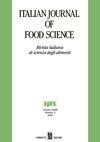Pretreatment of kaempferol-3-O-rutinoside protects H9c2 cells against LPS-induced inflammation through the AMPK/SIRT1 pathway
IF 3.3
4区 农林科学
Q2 FOOD SCIENCE & TECHNOLOGY
引用次数: 0
Abstract
Kaempferol-3-O-rutinoside (KR) is a flavonoid glycoside derived from traditional Chinese medicine, plants, and tea, and has good myocardial protection. This study focuses on the mechanism of myocardial protection with KR and whether myocardial protection can be achieved by activating the adenosine monophosphate-activated protein kinase–silent mating-type information regulation 2 homolog 1 (sirtuin) (AMPK/SIRT1) signal pathway. Molecular docking technique was used to predict the binding affinity of KR to AMPK. The inflammatory injury model of H9c2 cells was established by lipopolysaccharide (LPS) induction. H9c2 cell proliferation was detected by cell counting kit -8 assay. The apoptosis rate was measured by flow cytometry. Levels of interlukin (IL)-1β, IL-6, and tumor necrosis factor-α (TNF-α) were determined by enzyme-linked-immunosorbent serologic assay. AMPK and SIRT1 expression levels were quantified through reverse transcription-polymerase chain reaction and Western blotting assay. Results indicated that KR has a certain binding affinity with AMPK. KR could increase the growth of H9c2 inhibited by LPS, reduce apoptosis rate, and reverse the elevated levels of IL-1β, IL-6, and TNF-α. Furthermore, KR could suppress the expression levels of AMPK and SIRT1, and AMPK-specific inhibitor (Compound C) could significantly counteract the activation of KR, indicating that its anti-inflammatory effect is achieved by regulating the AMPK/SIRT1 signaling pathway.山奈酚-3- o -芦丁苷预处理通过AMPK/SIRT1途径保护H9c2细胞免受lps诱导的炎症
山奈酚-3- o -rutinoside (KR)是一种从中药、植物和茶叶中提取的类黄酮苷,具有良好的心肌保护作用。本研究的重点是KR的心肌保护机制,以及是否可以通过激活单磷酸腺苷激活的蛋白激酶沉默交配型信息调控2同源物1 (sirtuin) (AMPK/SIRT1)信号通路来实现心肌保护。利用分子对接技术预测了KR与AMPK的结合亲和力。采用脂多糖(LPS)诱导建立H9c2细胞炎症损伤模型。细胞计数试剂盒-8法检测H9c2细胞增殖。流式细胞术检测细胞凋亡率。采用酶联免疫吸附血清学法检测白细胞介素(IL)-1β、IL-6、肿瘤坏死因子-α (TNF-α)水平。通过逆转录聚合酶链反应和Western blotting检测AMPK和SIRT1的表达水平。结果表明,KR与AMPK具有一定的结合亲和力。KR能促进被LPS抑制的H9c2的生长,降低凋亡率,逆转IL-1β、IL-6、TNF-α水平升高。此外,KR可以抑制AMPK和SIRT1的表达水平,AMPK特异性抑制剂(Compound C)可以显著抵消KR的激活,表明其抗炎作用是通过调节AMPK/SIRT1信号通路来实现的。
本文章由计算机程序翻译,如有差异,请以英文原文为准。
求助全文
约1分钟内获得全文
求助全文
来源期刊

Italian Journal of Food Science
工程技术-食品科技
CiteScore
4.20
自引率
0.00%
发文量
33
审稿时长
>36 weeks
期刊介绍:
"Italian Journal of Food Science" is an international journal publishing original, basic and applied papers, reviews, short communications, surveys and opinions on food science and technology with specific reference to the Mediterranean Region. Its expanded scope includes food production, food engineering, food management, food quality, shelf-life, consumer acceptance of foodstuffs, food safety and nutrition, energy and environmental aspects of food processing on the whole life cycle.
Reviews and surveys on specific topics relevant to the advance of the Mediterranean food industry are particularly welcome.
 求助内容:
求助内容: 应助结果提醒方式:
应助结果提醒方式:


